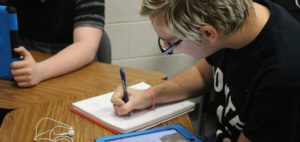 Originally published at educationdive.com
Originally published at educationdive.com
According to the T3 framework, ‘transcendent’ is the third and final stage of good ed tech use.
Gaylord Community Schools in northern Michigan had a bad experience with online learning. When it first brought new technology into its schools, students ended up becoming isolated. But Superintendent Brian Pearson has been leading a new charge for classroom technology, avoiding those old mistakes.
“We revamped what we did and started using technology to engage students and get them to work together collaboratively in a group, and use it to connect kids, not isolate kids,” Pearson said.
Teachers across the district have attended “Curriculum Camp,” which, among other things, has focused on incorporating technology into classroom instruction in productive ways. Ed tech purchasing has been demand-driven so teachers say what they want in their classrooms and make their appeals with clear instructional goals and curriculum plans in place. Pearson said that has led to more efficient use of funds and 100% utilization from the time of purchase, because teachers who request new technology already know how to use and implement the devices and programs with their students.
At Gaylord Community Schools, Sonny Magaña’s T3 Framework has been at the center of their shifting perspectives on technology in the classroom. Magaña’s new book, “Disruptive Classroom Technologies: A Framework for Innovation in Education,” outlines this framework and its three levels of school-based technology use.
In the first level, student learning with technology is categorized as translational. The second stage moves on to transformational and the third stage is called transcendent. Like other such frameworks, Magaña’s emphasizes active student learning that goes beyond what has been possible with paper and pencil for more than a century.
In the translational stage, students and teachers simply move traditional activities to digital platforms. Magaña said that can bring efficiencies to the classroom that mark some level of improvement, but students are stuck in consumption mode. The transformational stage turns them into producers.
“The transformational stage is when the use of technology tools enacts substantive changes in both the learning task that the student is doing and the learner doing the task,” Magaña said. “They are no longer the same person.”
Children using technology this way have higher levels of cognition, consciousness, confidence, agency and grit, Magaña said. Besides using digital tools to create, students in this stage use them to contribute to the learning of others. Students become teachers, and they get the confidence and motivation that comes with moving away from passive consumption of knowledge.
Magaña said most schools are stuck in the translational stage of technology use. A small number have moved into the transcendence stage. And few, if any, use digital technology in a transformational way, as far as Magaña sees it.
In his Michigan district, Pearson agrees they started out using educational technology in a translational way, but through professional development and a bit of a culture shift, he says many teachers spend much of their time in the transformational stage now.
Key, for Pearson, was the “Curriculum Camp,” which has brought Magaña and others to share their wisdom with every teacher in the district. The model has meant quick capacity-building districtwide. Before teachers would go to conferences in small groups or as individuals and come back full of excitement, but the spread of their knowledge was much slower.
Now one of Pearson’s key concerns is that there are so many new educational technologies on the market that they can be a distraction.
“The scary thing is that it moves so fast and new things come out and you could get caught up in the flavor of the month and lose track of your focus,” Pearson said.
The district has safeguards in place to ward off that problem. Grade-level teams and professional learning communities make the first request for a program or technology. A technology committee then reviews its compatibility with the district’s system and determines what type of training would be necessary for successful implementation. The last step, of course, is whether the budget can accommodate the request. Only if a product gets approval at every level does it make it into the classroom.
And while cost seems like an easy barrier to technology adoption, Magaña said there are many low-cost or free ways to get technology into students’ hands. The important part is making sure once it’s in classrooms, it is being used well.
“The problem isn’t money,” Magaña said. “The problem to solving technology integration is not financial, it’s visionary.”
